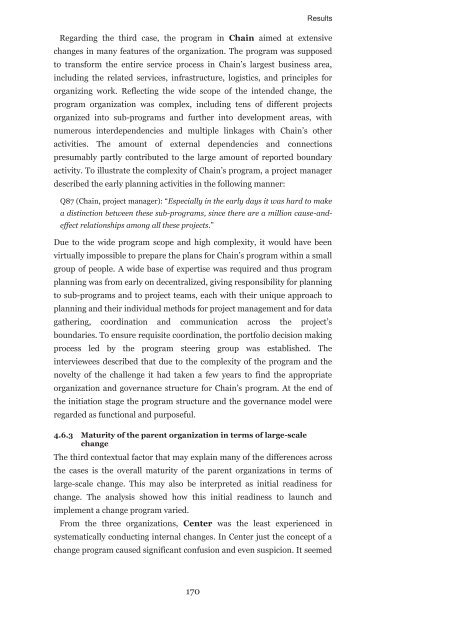Boundary activities and readiness for ... - Projekti-Instituutti
Boundary activities and readiness for ... - Projekti-Instituutti
Boundary activities and readiness for ... - Projekti-Instituutti
Create successful ePaper yourself
Turn your PDF publications into a flip-book with our unique Google optimized e-Paper software.
Results<br />
Regarding the third case, the program in Chain aimed at extensive<br />
changes in many features of the organization. The program was supposed<br />
to trans<strong>for</strong>m the entire service process in Chain’s largest business area,<br />
including the related services, infrastructure, logistics, <strong>and</strong> principles <strong>for</strong><br />
organizing work. Reflecting the wide scope of the intended change, the<br />
program organization was complex, including tens of different projects<br />
organized into sub-programs <strong>and</strong> further into development areas, with<br />
numerous interdependencies <strong>and</strong> multiple linkages with Chain’s other<br />
<strong>activities</strong>. The amount of external dependencies <strong>and</strong> connections<br />
presumably partly contributed to the large amount of reported boundary<br />
activity. To illustrate the complexity of Chain’s program, a project manager<br />
described the early planning <strong>activities</strong> in the following manner:<br />
Q87 (Chain, project manager): “Especially in the early days it was hard to make<br />
a distinction between these sub-programs, since there are a million cause-<strong>and</strong>effect<br />
relationships among all these projects.”<br />
Due to the wide program scope <strong>and</strong> high complexity, it would have been<br />
virtually impossible to prepare the plans <strong>for</strong> Chain’s program within a small<br />
group of people. A wide base of expertise was required <strong>and</strong> thus program<br />
planning was from early on decentralized, giving responsibility <strong>for</strong> planning<br />
to sub-programs <strong>and</strong> to project teams, each with their unique approach to<br />
planning <strong>and</strong> their individual methods <strong>for</strong> project management <strong>and</strong> <strong>for</strong> data<br />
gathering, coordination <strong>and</strong> communication across the project’s<br />
boundaries. To ensure requisite coordination, the portfolio decision making<br />
process led by the program steering group was established. The<br />
interviewees described that due to the complexity of the program <strong>and</strong> the<br />
novelty of the challenge it had taken a few years to find the appropriate<br />
organization <strong>and</strong> governance structure <strong>for</strong> Chain’s program. At the end of<br />
the initiation stage the program structure <strong>and</strong> the governance model were<br />
regarded as functional <strong>and</strong> purposeful.<br />
4.6.3 Maturity of the parent organization in terms of large-scale<br />
change<br />
The third contextual factor that may explain many of the differences across<br />
the cases is the overall maturity of the parent organizations in terms of<br />
large-scale change. This may also be interpreted as initial <strong>readiness</strong> <strong>for</strong><br />
change. The analysis showed how this initial <strong>readiness</strong> to launch <strong>and</strong><br />
implement a change program varied.<br />
From the three organizations, Center was the least experienced in<br />
systematically conducting internal changes. In Center just the concept of a<br />
change program caused significant confusion <strong>and</strong> even suspicion. It seemed<br />
170









